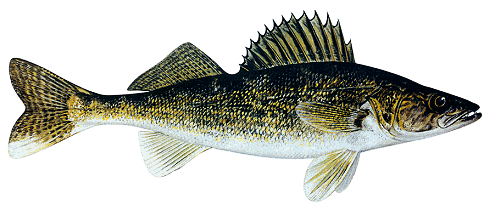I've mentioned several times about fly fishing for Walleyes locally. The
reaction is usually "No way, Dude . . ." and my response is "Way, Dude!" First of
all, the little river I live on is one of the top Walleye hatcheries in the
state, which really helps the situation. But I've also caught them in other
areas, so it's not a unique situation. Neither are the methods. I do need to
caution you here about one big difference, there are river Walleyes and there
are lake Walleyes, and I fish for river Walleyes. Now they are the same fish,
same species, same right down to the bright white, glassy eyes and sharp
teeth, but I've never been able to catch a lake Walleye. They usually run too
deep for even my methods and are usually trolled for with down riggers and
other deeper water equipment. (of course, if you really want to go for it you
could probably hook your fly rod into a down rigger and troll with the other
guys . . . No Comments Please . . . Just don't tell me about it!)

First of all you need to take a look at equipment. Walleyes are
powerful fish with a nasty row of very sharp teeth. I fish with a minimum of
a 6wt rod. I'll soon have my 10wt finished which should shorten the fight
time, but for now, the 6wt works for the smaller 1 to 4 pound fish. Next is
the line. Walleyes normally stay relatively close to the bottom so you need a
line that will get your fly down there, and keep it down there in the current
during the retrieve. I use a wt forward, fast sink line (there are plenty of
brands out there so I won't mention any names and wind up ticking someone
off . . .) Next comes the leader. Please keep in mind, these fish have teeth,
plus sharp gill plates. When hooked they have a tendency to
turn and run, hook your line under their gill plates and either chew
through your line or cut it with their gill plates. To keep that from
happening, you need either a steel leader with a snap swivel or a strong
monofilament line, somewhere in the 15 to 30 pound range, about 3 to 6 feet in
length.
I've also started changing over to some of the new braided lines usually
reserved for those bait casters, just remember not to run the braided lines
through your Tip guide on the retrieve or they WILL cut right through your
guide, especially when your bringing in a fish! The longer the leader the
more natural action it'll give to the fly, to a point. I don't use a tippet,
but tie directly to the leader and I use super glue on the knot, especially on
the braided lines. (Beginning to sound similar to heavy salt water fishing?
Just hook on to a 30 inch 9 pound Walleye some time!)
Now on to the flies I use. I started out fishing Walleyes using bait casters
and spinning rods. Using down riggers, or casting long and letting it sink,
or trolling (and yes, occasionally I still do, again don't write me and chew
on me about this point . . . I enjoy fishing, by any method or means!) The lures
used in those methods are usually fat lipped, deep diving, crank baits, or
lead head jigs, tipped with worms, leeches or minnows. Well, that gives us a
few references as to what kind of flies we need for the fish. I have caught a
few Walleyes during their early season spawning on light flies, but for the
most part they are usually deep running, weighted flies. For this area, and
it may be a little different in yours, you'll have to do some experimenting,
modified Clouser Minnows, Light and Dark Spruces, and Lefty Deceivers seem to
work. By 'modified,' I mean adding weight and varying the colors. By weight,
I mean under wrapping the body with extra lead and/or using larger, heavier
dumbbell eyes.
Walleyes seem to look at things a little differently than other fish when it comes
to color. Most of the Walleye flies I use do not resemble the forage fish, in color at
least, at all. I use a lot of chartreuse, bright blue, orange, yellow, and
white. In addition I use a whole lot of tinsel and flashabou. For example, I
tie a Clouser Minnow, using a #1 or 2 or 3x long hook, (and I've also gone up
to 0/1 size) wrapped with lead and a 1/8th to 1/4th ounce dumbbell for the
eyes. Then, instead of the 'normal bass pattern' I use chartreuse top with a
red bottom (always, with the hook point up and the dumbbell down). I also add
a few strands of tinsel between the colors for attraction. Other patterns
using the Clouser as a 'base' is blue top, a thin strip of red and a white
bottom and an orange top, a thin strip of red, and a white bottom. The
Spruces are tied in about the same 'offbeat' colors, they just don't have the
dumbbell eyes, so they will run a little shallower. The Deceivers are pretty
good just the way Lefty Kreh ties them, color wise, just add the lead under
wrapping for weight. I'm sure there are a number of others out there but,
like I said, these work here. Occasionally I'll pick one or two up while
fishing for small mouth bass using a weighted crayfish pattern, but for the
most part I stick with the other flies.
Okay, now you know what I use for equipment and flies. You still need to know
the method to the madness. Like I said before, Walleyes seem to be creatures
of different habits than other fish. I've caught them in shallow riffles, in
swirling cut backs, on the back side of river bends, near structure, such as
trees or large rocks and suspended just off the bottom, in the middle of the
main channel. The only thing in common was the river current and depth. They
seem to prefer deeper water with a fairly strong current. They have a
tendency to use structure to break up the current, which disorients the
smaller bait fish they feed on. So that's the type of water I look for,
strong running water, with structure of some kind breaking the current or deep
pockets behind rocks or trees in shallower riffles. Getting the fly into
those areas usually involves casting at a 90 degree angle to the current and
then working the fly in the current into those areas. Sound like a lot of
work or a challenge? I never said it was going to be easy, but the payback of
hooking onto a decent sized walleye is one you'll never forget! Remember, use
the current and the weight of the fly, let them do most of the work. Mend the
line or strip out a little more, depending on position. Lastly, keep in mind
that when a walleye bites, it's a very light bite, so be prepared for a "peck"
and not a rip on the line, then set the hook. Once the hook is set you'll get
the reel ripping excitement and the adrenaline rush you've been waiting for!
Use a landing net and a forceps to remove the fly -- do not try to "lip" these
fish unless you want a shredded thumb or finger. Remember, the teeth are very
sharp and the gill plates can be almost like a razors edge, not to mention the
points on the dorsal fins!
The last tip came to me from an 'old timer' who said, "If ya ain't losing
some tackle then ya ain't gonna catch no walleye!" So tie plenty of flies and
expect to loose some in the process to snags and hangups. Have fun and good
luck!
That's it for this week. Again, if you have any other questions, comments or
advice, please feel free to write.
~ Randy Fratzke
P.S. Catch and release is one thing, but Walleye is one of the best
tasting fish out there! So release when you can, but save one or two for
dinner.
|


